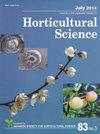Improved Light Conditions at the Fruit Truss Accelerate Harvest Time and Enhance Ascorbic Acid Concentration in a Low-truss, High-density Tomato Production System
Journal of The Japanese Society for Horticultural Science
Pub Date : 2013-01-01
DOI:10.2503/JJSHS1.82.317
引用次数: 11
Abstract
Light conditions are poor around the lower trusses of tomato plants in a low truss number, high plant density production system. We determined the effects of leaf rearrangements above the fruit trusses on fruit maturation and quality in tomato plants pinched above the third truss and cultivated under a high-density growing system. Integrated solar radiation at first and second fruit trusses and surface temperature of fruits at second fruit truss were increased in plants treated with leaf rearrangements above the trusses compared with those of the control, and the maturation of fruits at the third truss treated with leaf rearrangement was 4.6 days earlier than that of the control. The concentration of ascorbic acid (AsA) in fruits of plants treated with leaf rearrangement was higher than that of control fruits. However, leaf rearrangement had no effect on yield and Brix of the fruit. These results indicated that higher solar radiation together with leaf rearrangement promoted fruit maturation and increased AsA content in the fruit of lower trusses of tomato plants cultivated under a low truss number, high plant density growing system.在低架高密度番茄生产体系中,改善果架光照条件加快收获时间,提高抗坏血酸浓度
在低桁架数、高密度的生产体系中,番茄植株下部桁架周围光照条件较差。研究了高密度栽培体系下,果实架上方叶片重排对果实成熟和品质的影响。果架上方叶片重排处理的第一、第二果架综合太阳辐射和第二果架果实表面温度均比对照提高,第三果架果实成熟时间比对照提前4.6 d。叶片重排处理植株果实中抗坏血酸(AsA)浓度高于对照果实。然而,叶片重排对果实的产量和糖度没有影响。上述结果表明,在低架数、高密度生长体系下,较高的太阳辐射和叶片重排促进了低架番茄果实的成熟,增加了果实中AsA的含量。
本文章由计算机程序翻译,如有差异,请以英文原文为准。
求助全文
约1分钟内获得全文
求助全文
来源期刊
自引率
0.00%
发文量
0
审稿时长
>36 weeks

 求助内容:
求助内容: 应助结果提醒方式:
应助结果提醒方式:


